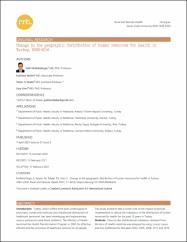| dc.contributor.author | Mollahaliloğlu, Salih | |
| dc.contributor.author | Yardım, Mahmut | |
| dc.contributor.author | Telatar, Tahsin Gökhan | |
| dc.contributor.author | Üner, Sarp | |
| dc.date.accessioned | 2022-08-17T05:13:00Z | |
| dc.date.available | 2022-08-17T05:13:00Z | |
| dc.date.issued | 2021 | en_US |
| dc.identifier.citation | Mollahaliloglu, S., Yardım, M., Telatar, T. G., & Uner, S. (2021). Change in the geographic distribution of human resources for health in Turkey, 2002-2016. Rural and remote health, 21(2), 6478. https://doi.org/10.22605/RRH6478 | en_US |
| dc.identifier.issn | 1445-6354 | |
| dc.identifier.uri | https://doi.org/10.22605/RRH6478 | |
| dc.identifier.uri | https://hdl.handle.net/11436/6365 | |
| dc.description.abstract | Introduction: Turkey, which suffers from both undersupply of physicians, nurses and midwives and imbalanced distribution of healthcare personnel, has been developing and implementing various policies to solve these problems. The Ministry of Health launched the Health Transformation Program in 2003 for effective, efficient and fair provision of healthcare services for all people. This study aimed to take a closer look at the impact of policies implemented to reduce the imbalance of the distribution of human resources for health for the past 15 years in Turkey.
Methods: Data for the distributional imbalance obtained from Ministry of Health registries was analysed by using Lorenz curves and Gini coefficient for the years 2002, 2005, 2008, 2012 and 2016.
Results: Geographical imbalances for healthcare professions decreased distinguishably during the 15 years. Gini coefficient was 0.33 for specialist distribution in 2002, and decreased gradually to 0.26 in 2008 and finally 0.21 in 2016. Similarly, Gini coefficients were 0.18, 0.20 and 0.25 for general practitioners, nurses and midwives, respectively, in 2002. In 2012, Gini coefficients for the same professionals were calculated as 0.09, 0.11 and 0.19, respectively.
Conclusion: The findings indicate that the policies targeting the distribution of healthcare personnel in Turkey have yielded positive results. Yet it is evident that these results are not due to a single action. It is essential to improve existing implementations, identify the instruments and factors that satisfy and motivate healthcare personnel, and continue developing and implementing comprehensive policies. | en_US |
| dc.language.iso | eng | en_US |
| dc.publisher | Medicine and Dentistry James Cook University | en_US |
| dc.rights | info:eu-repo/semantics/openAccess | en_US |
| dc.subject | Geographic distribution | en_US |
| dc.subject | Gini coefficient | en_US |
| dc.subject | Human resources for health | en_US |
| dc.subject | Lorenz curve | en_US |
| dc.subject | Turkey | en_US |
| dc.title | Change in the geographic distribution of human resources for health in Turkey, 2002-2016 | en_US |
| dc.type | conferenceObject | en_US |
| dc.contributor.department | RTEÜ, Tıp Fakültesi, Dahili Tıp Bilimleri Bölümü | en_US |
| dc.contributor.institutionauthor | Telatar, Tahsin Gökhan | |
| dc.identifier.doi | 10.22605/RRH6478 | en_US |
| dc.identifier.volume | 21 | en_US |
| dc.identifier.issue | 2 | en_US |
| dc.identifier.endpage | 6478 | en_US |
| dc.relation.journal | Rural and Remote Health | en_US |
| dc.relation.publicationcategory | Makale - Uluslararası Hakemli Dergi - Kurum Öğretim Elemanı | en_US |


















